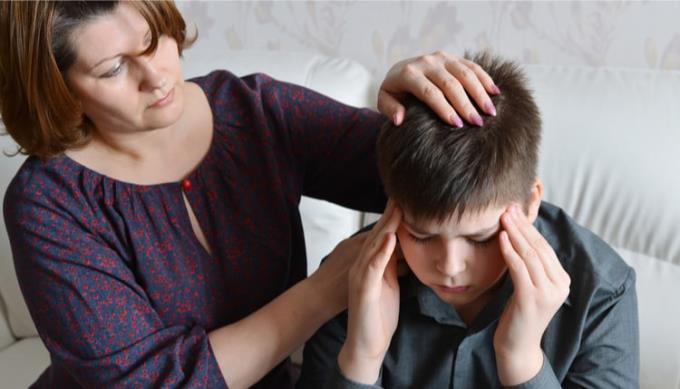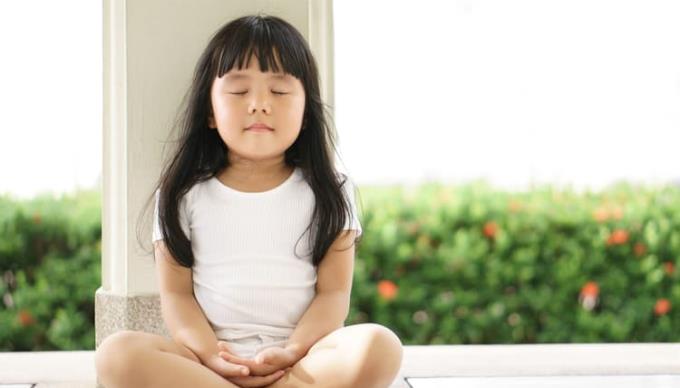Ways to determine an infants caloric needs

Learn how to determine your baby’s caloric needs, including the calories in breast milk and formula, to ensure your infant gets the right nutrition for healthy growth.
Headache in children is a common medical condition, accounting for up to 90% of school age children. However, not all parents fully understand this disease.
No one thinks that children have headaches, but the reality is that headaches are very common in children. About 20% of children 5–17 years old have a headache each year. Therefore, if your baby tells you he has a headache, don't think he's joking.
Your baby will often feel pain, throbbing pain, or pain like a hammer. The pain may last for only a few minutes, but it can last longer.
Headaches have many causes, but the most common are:
Skipping meals
Dehydration (often causes headaches in children and adults)
Cry too much.
To determine the cause of childhood headaches, you need to understand the common types of headaches.
There are two types of headaches: primary headaches and secondary headaches. The main type of headache is when the headache is not caused by another medical condition. In contrast, the secondary headache is caused by other diseases such as sinus infection, neck injury ...
Headaches and migraines are the two most common types of headaches. Tension headaches usually occur in children and teenagers and only last for a few minutes. The aching pain is often described as a tightening sensation on the sides of the head, sometimes appearing on the forehead, the back of the head and neck, or both of these areas.
About 10% of teenage babies get migraines. The headaches usually start suddenly, are pulsating and often have headaches on one side. Some babies may experience pain on both sides. Pain progression can last for hours, sometimes all day. Nausea and vomiting are often associated with headaches.
Several diseases cause additional headaches:
Neck injury
Sinus, eyes, teeth, ear or other problems
Have mild or severe depression
Infection.
Sometimes, headaches can be a sign of a tumor. Therefore, you should pay attention if your baby tells you he has a headache.
Cluster headaches usually appear in babies 10 years of age and older. The headaches usually begin on one side, appear suddenly, strongly, first in and around the eyes and then spread to the half of the neck, face, and head. The pain usually lasts about a week or a month. If your baby is in pain, you will notice that the painful side of your baby will be blocked from the nose, blushing, pupil shrinkage, drooping eyelids, bulging eyes and other symptoms.
Headaches in children are often caused by migraines, stress, and dehydration. However, if your baby has the following symptoms, you should consider:
Occurs often during the month
Babies often have pain when they wake up and the pain does not go away even after enough sleep
Persistent pain
The pain became more and more intense
Headache is accompanied by symptoms such as fever, neck pain, nausea, decreased vision ...
Loss of consciousness.
If your baby has any of the above signs, you should take your baby to the hospital for immediate examination and treatment.

Each type of headache has different symptoms. However, these symptoms differ mainly in the intensity of pain, duration and effects of the baby's daily activities. Migraines, for example, are often accompanied by:
Reduced vision
Sweat
Nausea and vomiting
Sensitive to light and sound.
Symptoms of tension headaches:
The pain is mild to moderate and dull
Pain usually occurs on the sides of the head
Your baby's sleeping habits change
Pain in the shoulder and neck.
The following children's symptoms suggest that headache is a sign of a serious illness:
Headaches often
Sudden severe pain
Headache when waking up
Pain that gets worse when your baby coughs, sneezes or moves his head
Headache is dull, ranging from mild to severe
Nausea or vomiting whenever a headache
Reduced vision
Personality changes
Legs become weak, having difficulty moving
Epileptic.
Diagnosis is a way to determine the exact cause of a child's headache and to understand the severity of this symptom. First, the doctor will exploit the baby's medical history, then ask you to have your baby do some tests. The questions the doctor will ask:
When do headaches usually occur?
Headache on which side?
How long does the pain usually last?
Have a head injury or not?
Have eating and sleeping habits changed?
Does the pain appear in a particular position?
Is your baby having trouble sleeping?
Is my baby showing signs of depression or stress?
Sometimes the doctor will ask you to give your baby some tests to diagnose. Tests may be ordered:
Magnetic resonance imaging to check for tumors, cerebral vascular malformations, and other abnormalities
Cranial tomography helps diagnose tumors or infections
Polysomnogram (Polysomnogram)
Puncture of cerebrospinal fluid if meningitis or encephalitis is suspected.
Treatment of headaches in children depends on factors such as:
Baby's age
Type of headache and frequency of attacks
Anamnesis.
Treatment methods for children such as: getting enough rest, taking medicines, changing life habits and using therapies.
If your baby has tension headaches or tension headaches, let him rest.
The pain reliever ibuprofen or acetaminophen is often used to treat children's headaches. However, you should not give aspirin to your baby. The best way is to consult your doctor before giving the medicine to your baby.
To treat migraines, the doctor prescribes Antofan, a safe and effective medicine for babies. This medicine will help relieve pain, control nausea and vomiting.
Sometimes, using the wrong medication can also cause headaches in children. Therefore, you should consult your doctor before giving any medicine to your baby.

If your baby has psychological problems such as depression or anxiety, you should use therapies to treat it.
Therapies such as yoga, breathing exercises, and meditation also help relieve stress. Cognitive-behavioral therapy is often used to treat depression.
Biological rehabilitation is a therapy that improves the patient's health by controlling unconscious body activities such as heart rate, blood pressure ... By controlling basic reactions in the muscles. This method will help control and accurately identify pain factors, thereby improving effectiveness of pain treatment and prevention.
Acupuncture and massage also help relieve tension headaches.
Substances like magnesium, riboflavin and Coenzyme Q-10 also reduce the duration of pain duration.
You can help prevent headaches with the following measures:
Don't expose your baby to loud music or lights that are too bright and avoid excessive stress.
Getting enough sleep, lack of sleep is often the cause of headaches in children.
Ice will also help relieve pain.
If your baby has migraines, keep the surroundings as quiet as possible.
Fear and anxiety often cause headaches. Therefore, let your baby practice some breathing exercises or meditate to reduce stress.
Feed your baby nutritious foods such as fresh fruits, green vegetables, and avoid foods with too much grease.
Give your baby plenty of fluids to prevent headaches caused by dehydration.
If your baby has frequent headaches, you should pay attention to the following:
When did the headache occur?
How long does the pain last?
What did your baby do before he was hurt?
What did your baby eat before he was hurt?
What do babies usually do to relieve pain?
Take note of your baby's diet, activities and moods to find out the cause of the headache.
Some natural herbs also help with headaches:
Chamomile has the effect of treating and preventing migraine.
Peppermint oil has a calming effect on the nerves, helping to relieve tension headache symptoms. Take a tablespoon or two of peppermint oil mixed with almonds, rub the temples to treat.
Breathing lavender oil or eucalyptus oil also helps relieve headaches.
Cinnamon has a stress-relieving effect. Add a pinch of cinnamon to a glass of warm milk to help relieve headache pain.
Cloves also have analgesic properties. Add cloves to baby food or chew them raw.
These remedies do not always work. If you are not comfortable, take your baby to see a doctor for appropriate treatment.
A healthy diet is an effective way to prevent headaches. In addition, you should practice babies the habit of eating and sleeping at the same time every day to have a good health. Please refer to the article " Babies cough and decode their coughs " for more information.
Learn how to determine your baby’s caloric needs, including the calories in breast milk and formula, to ensure your infant gets the right nutrition for healthy growth.
Discover the top 5 smartest dog breeds in the world, including Border Collie, Poodle, German Shepherd, Golden Retriever, and Doberman Pinscher. Learn about their unique traits and why they are considered the most intelligent dogs.
Discover 7 nutritious and delicious ways to cook egg porridge for babies, including recipes with cheese, pumpkin, tomato, and more. Learn how to prepare baby-friendly egg porridge with our expert tips.
After a series of medical measures they obtained a complete human vascular system profile.
Watermelon is one of the fruits that many people love, not only cheap but also delicious, nutritious and refreshing in the summer. To get delicious watermelon pieces, show off your housewives, your artistic talents to cut beautiful pieces of watermelon.
aFamilyToday Health - The digestive system and body in each baby is different. Parents need to recognize notes to deal with when babies have a food allergy!
Babies need many factors for perfect development. aFamilyToday Health shares with parents things to keep in mind when babies are 8 weeks old so that parents can take care of their babies the best!
Babies need many factors for perfect development. aFamilyToday Health shares with parents things to keep in mind when babies are 18 weeks so that parents can take care of their babies the best!
Babies need many factors for perfect development. aFamilyToday Health shares with parents things to keep in mind when babies are 28 weeks old so that parents can take care of their babies the best!
Babies need many factors for perfect development. aFamilyToday Health shares with parents things to keep in mind when babies are 32 weeks old so that parents can take care of their babies the best!








